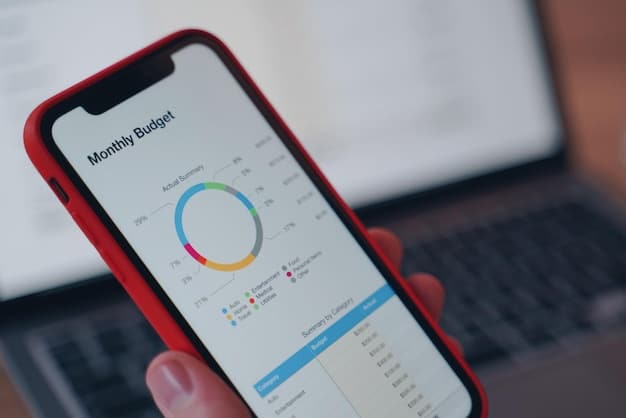The Ultimate Guide to Mobile E-commerce Optimization: Boost Sales

The Ultimate Guide to Mobile E-commerce Optimization: Boost Sales by 20% in the Next Quarter offers actionable strategies to enhance user experience, streamline purchasing processes, and leverage mobile-specific features, driving significant revenue growth.
Mobile e-commerce is no longer a trend; it’s the present and future of online shopping. Are you ready to unlock its full potential and see a tangible increase in your sales figures? This comprehensive guide reveals the strategies that can transform your mobile platform and help you achieve that ambitious 20% sales boost.
In today’s mobile-first world, failing to optimize your e-commerce site for mobile devices means leaving money on the table. This The Ultimate Guide to Mobile E-commerce Optimization: Boost Sales by 20% in the Next Quarter provides the necessary tools and knowledge to not only attract mobile shoppers but also convert them into loyal customers. Dive in and discover how to make every tap, swipe, and scroll count.
Understanding the Mobile E-commerce Landscape
The mobile e-commerce landscape is rapidly evolving, demanding businesses to adapt and optimize their strategies. Understanding the nuances of this ever-changing market is crucial for long-term success and achieving significant gains in sales.
The Rise of Mobile Shopping
Mobile shopping has surged in popularity, driven by increased smartphone usage and the convenience it offers. Consumers now prefer browsing and purchasing products on their mobile devices anytime, anywhere.
Key Statistics and Trends
Several key statistics highlight the importance of mobile e-commerce. Conversion rates on mobile devices continue to climb, and mobile commerce is projected to account for a substantial portion of total e-commerce sales in the coming years.
- Mobile commerce is projected to represent over 70% of total e-commerce sales by 2025.
- Mobile conversion rates have increased by over 20% in the last year.
- Customers are spending an average of 3 hours per day on their mobile devices.
To stay competitive, businesses must optimize their mobile platforms to provide seamless and engaging shopping experiences. Failing to do so will result in missed opportunities and lost revenue.

Understanding the mobile e-commerce landscape involves being aware of these trends and leveraging them to your advantage. By focusing on optimizing your mobile presence, you can boost sales and grow your customer base effectively.
Optimizing Your Mobile Website for Conversions
Optimizing your mobile website is essential for increasing conversions and providing a seamless user experience. This involves several key areas, from improving site speed to simplifying the checkout process.
Improving Site Speed
Site speed is a critical factor in mobile e-commerce. Slow loading times can frustrate users and lead to high bounce rates. Optimizing images, leveraging browser caching, and using a content delivery network (CDN) can significantly improve site speed.
Responsive Design and User Experience
A responsive design ensures that your website adapts seamlessly to different screen sizes and devices. This not only improves the user experience but also boosts your search engine rankings. A well-designed mobile site is intuitive, easy to navigate, and visually appealing.
- Use a clean and simple layout.
- Ensure easy navigation with clear menus.
- Optimize images and videos for mobile devices.
By focusing on responsive design and providing a user-friendly experience, you can keep visitors engaged and encourage them to make a purchase.
Optimizing your mobile website requires a comprehensive approach that addresses both technical aspects like site speed and design elements like user experience. When done correctly, this can lead to higher conversion rates and increased customer satisfaction.
Leveraging Mobile-Specific Features
Mobile devices offer unique features that can enhance the shopping experience. Leveraging these features effectively can set your e-commerce platform apart from competitors and increase customer engagement.
Push Notifications
Push notifications are a powerful tool for engaging with customers. They can be used to send personalized messages, promote sales, and remind users about abandoned carts. However, it’s important to use them sparingly and provide real value to avoid irritating users.
Mobile Wallets and One-Click Payments
Integrating mobile wallets and one-click payment options simplifies the checkout process. This provides a seamless purchasing experience, reducing friction and encouraging repeat purchases. Popular options include Apple Pay, Google Pay, and PayPal One Touch.

Geolocation Services
Geolocation services can enhance the shopping experience by providing location-based offers and personalized recommendations. This can be particularly effective for businesses with physical store locations or for offering local deals.
By strategically using push notifications, integrating mobile wallets, and leveraging geolocation services, you can create a more personalized and engaging shopping experience. This will not only attract more customers but also foster loyalty and drive sales.
Mobile SEO Best Practices
Mobile SEO is crucial for ensuring that your e-commerce site ranks well in search results on mobile devices. Optimizing your site for mobile search involves several key strategies, from improving site speed to using mobile-friendly keywords.
Optimizing for Mobile Keywords
Mobile users often use different keywords than desktop users. Identifying and targeting these mobile-specific keywords is essential for improving your search engine rankings. This involves conducting keyword research to find relevant terms that mobile users are searching for.
Mobile-First Indexing
Google uses mobile-first indexing, meaning that it primarily uses the mobile version of a website for indexing and ranking. Therefore, it’s crucial to ensure that your mobile site is well-optimized and provides a high-quality user experience.
- Ensure your mobile site loads quickly.
- Use a responsive design that adapts to different screen sizes.
- Optimize images and videos for mobile devices.
Implementing these mobile SEO best practices will not only improve your search engine rankings but also enhance the overall user experience on your mobile site. Ultimately, this can lead to increased traffic, conversions, and sales.
Mobile SEO is an ongoing process that requires constant monitoring and adjustment. Businesses must stay up-to-date with the latest trends and best practices to maintain a competitive edge in the mobile e-commerce landscape.
Measuring and Analyzing Mobile E-commerce Performance
Measuring and analyzing your mobile e-commerce performance is crucial for identifying areas for improvement and making data-driven decisions. Several key metrics can provide valuable insights into your mobile strategy.
Key Performance Indicators (KPIs)
Key Performance Indicators (KPIs) are essential metrics that provide insights into the success of your mobile e-commerce efforts. Common KPIs include conversion rates, bounce rates, average order value, and customer acquisition cost.
Using Analytics Tools
Analytics tools like Google Analytics and Adobe Analytics provide valuable data about user behavior on your mobile site. These tools can help you track KPIs, identify trends, and understand how users are interacting with your site.
By closely monitoring KPIs and using analytics tools, businesses can gain a deeper understanding of their mobile e-commerce performance. This enables them to make informed decisions, optimize their strategies, and achieve their sales goals.
Regularly analyzing your mobile e-commerce performance is essential for continuous improvement. Stay informed about the latest trends and best practices and adapt your strategy accordingly to maximize your results.
Strategies for Long-Term Mobile E-commerce Success in the US Market
Achieving long-term success in the US mobile e-commerce market requires a combination of effective strategies and a customer-centric approach. Staying ahead of the curve and continuously adapting to changing trends is essential for sustained growth.
Personalization and Customer Engagement
Personalization is key to creating a memorable and engaging shopping experience. Tailoring product recommendations, offering personalized discounts, and providing exceptional customer service can foster customer loyalty and drive repeat purchases.
Staying Ahead of Trends
The mobile e-commerce landscape is constantly evolving, with new technologies and trends emerging regularly. Keeping up with these changes and adapting your strategy accordingly is crucial for long-term success. Embracing innovation and experimenting with new features can set your e-commerce platform apart from the competition.
By focusing on personalization, staying ahead of trends, and prioritizing customer satisfaction, businesses can build a strong foundation for long-term mobile e-commerce success in the US market. The Ultimate Guide to Mobile E-commerce Optimization: Boost Sales by 20% in the Next Quarter involves continuous effort and adaptation.
| Key Point | Brief Description |
|---|---|
| 🚀 Optimize Mobile Site | Improve speed, design, and user experience for conversions. |
| 📱 Use Mobile Features | Leverage push notifications, wallets, and geolocation. |
| 🔎 Mobile SEO | Focus on mobile keywords and site indexing. |
| 📈 Analyze Performance | Monitor KPIs and use analytics tools for insights. |
Frequently Asked Questions
To improve site speed, optimize images, leverage browser caching, and use a content delivery network (CDN). Aim for a load time of under 3 seconds to reduce bounce rates.
Push notifications help engage customers, promote sales, and remind users about abandoned carts. They can significantly increase conversion rates when used strategically and sparingly.
Optimize for mobile-specific keywords, ensure your site is mobile-friendly, and focus on mobile-first indexing. This will improve your search engine rankings on mobile devices.
Responsive design ensures your website adapts seamlessly to various screen sizes, improving user experience and boosting search engine rankings. It’s critical for engaging mobile shoppers.
Monitor key performance indicators (KPIs) such as conversion rates, bounce rates, and average order value using analytics tools like Google Analytics and Adobe Analytics.
Conclusion
Mastering mobile e-commerce is crucial for any business looking to thrive in today’s digital landscape. By focusing on optimization, leveraging mobile-specific features, and analyzing performance, you can unlock the full potential of your mobile platform. This The Ultimate Guide to Mobile E-commerce Optimization: Boost Sales by 20% in the Next Quarter equips you with the knowledge to drive sales growth.
Embrace these strategies to create a seamless and engaging shopping experience that resonates with your customers and drives meaningful results. Success in mobile e-commerce requires continuous adaptation and a customer-centric focus. By prioritizing these factors, you can achieve sustainable growth and stay ahead of the competition.





